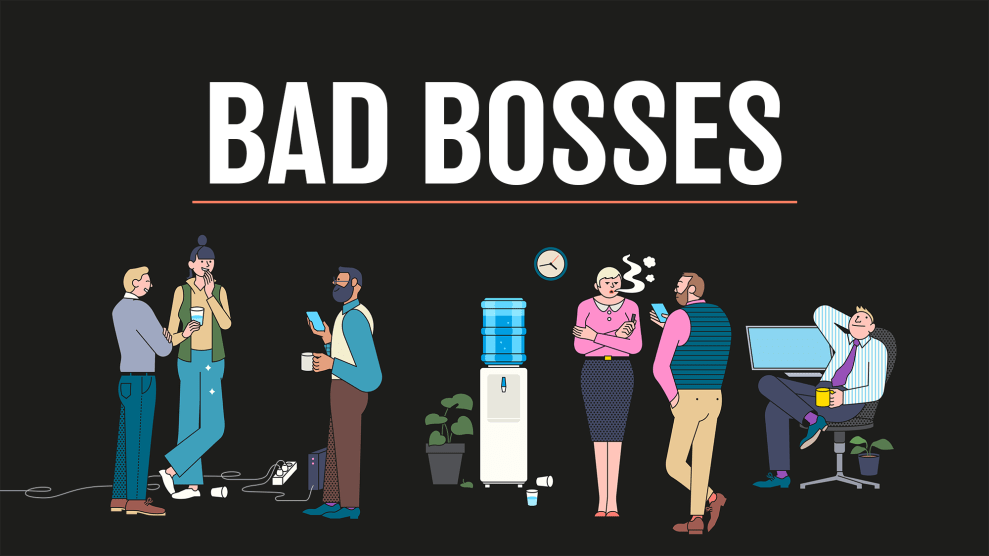
Mother Jones illustration
Parts of this article have been adapted for the cover story of our January + February 2022 issue. You can read that essay here.
Twice in the last year, a Walmart employee has quit via intercom. Last month in Louisiana, Beth McGrath took to the speaker to announce “Beth from electronics” was going to “quit” because the company treats some employees “like shit.” This came almost exactly a year after Shana Blackwell—a night stocker in Texas—announced to her whole Walmart that she “fucking quit” her job because the “company treats their employees like shit.” There’s no need for a third exact copy—intercom, Walmart, “like shit”—to notice a pattern: People are rejecting bad working conditions and quitting at rates we haven’t seen in decades.
One report found that this year, 1 in 4 workers quit their jobs. In August 2021 alone, around 4.3 million people quit—that is 2.9 percent of the total US workforce. There have never been that many in a single month since 2000, when the Labor Department began tracking quitters.
The recent spike in this so-called Great Resignation has enflamed an already kindling debate about how COVID-19, and the government’s response to it, has reshaped labor: Are we seeing a new relationship to work? A “backlog” of quits? An “unofficial general strike“? In these discussions, the quits are often presented as being prompted by personal enlightenment. A popular idea is of an equal opportunity satori, in which a series of “pandemic epiphanies” have pushed us all to question American assumptions about work—a notion Anthony Klotz, a professor of organizational behavior who is credited as coiner of “The Great Resignation,” has trumpeted. A dangerous spin on that explanation is the myth of increased laziness prompted by government assistance: Americans don’t feel they have to work.
The parable of the loss of grit is a long-running one and has picked up steam lately with this quits data. Conservatives have loudly decried that the quits are part of a “labor shortage” driven by government benefits that are killing the economy. This hysteria led Republican governors to cut unemployment aid—which, of course, did not work the way they wanted: An analysis by the Associated Press found that in the states that cut aid, there was no uptick in those in or trying to join the workforce. But in the states that kept some aid? A small bump in the number of people in the workforce.
In all these conversations, and in particular in this worry about an “entitlement mindset,” we’re largely missing the point. As economist David Autor explained in the New York Times, this labor shortage (and the quits) are likely driven less by lack of desperation than the acuteness of it for United States workers over decades. For the past 40 years, Autor writes, the United States has “generated vast numbers of low-paid, economically insecure jobs.” On top of that, we haven’t invested in social infrastructure, which means some are dropping out of the workforce because they are falling through the purposely cut holes in our social safety net. Research from economists and other reports show workers are pissed off and burnt out right now. There is increased labor organizing. There have been a series of major actions (and almost strikes) by film workers, John Deere employees, and Kaiser nurses. Quits, in this context, can be seen as an indication that the idea that work is hell has been allowed room to breathe during the era of COVID-19. People are done—from the white collar workers reconsidering their life priorities, to the service industry staff tired of potential death and bad customers, to the long running conditions of low-wage labor crystalized by a pandemic.
This assessment is bleak, yes, but it’s also promising. “Quits” is a Janus-faced economic data point—a sign of both how bad our work politic has gotten, and also hope that somewhere it could be better. It signals that people are fed up. But also that they have the confidence in finding new work, often that is better paid. It’s important to emphasize how the fiscal response to COVID-19 stopped a prolonged recession, like the one seen after 2008. As labor economist Lawrence Katz explained to the Harvard Gazette, with “the expansion of the social safety net and the stimulus payments during the pandemic period,” many were opened up to the possibility to get pissed off. Bank accounts are slightly up at the moment. So are job openings. Savings—bolstered by the economic policies in response to COVID-19, many of which ended in September in the US—have allowed some to try to skate by without a job for a few months. This cushion—while unevenly distributed—is helping people quit.
Sure, just getting a clump of quits data allows one to—as Mike Konczal, an economist at the left-leaning Roosevelt Institute, has pointed out—prognosticate about quitters being on the dole. But that ignores all the hiring going on:
If you are going to mention that quits are at record levels, you should also mention that hiring, from the same survey, is also at record levels.
That survey can't tell the difference between quits into employment versus unemployment; but we know the former is up a great deal. pic.twitter.com/CrvgIhdtgW
— Mike Konczal (@rortybomb) October 26, 2021
On a mass scale, there are “very few things that help manifest a healthy market economy more than [quits],” Guy Berger, an economist for LinkedIn, tells me. So, if you can quit your shitty job, that’s a good thing. As Autor wrote, the labor shortage gives us chance to “catalyze better working conditions for those who need them most.” We can see this moment as an “opportunity, not a crisis.”
To fully unpack why we should see hope here, it helps to understand what “Quits” actually are—and who is behind them. The Labor Department collects quits data by asking a handful of employers who left and why. The firms tell the department who quit, retired, or was fired. That means quits include those leaving one job for another, taking a few months off, and dropping out of the labor force.
When you go deeper, the picture gets more interesting. It is not just one thing happening. For certain groups, job switching looks “unusually high right now,” Katz told the Gazette, which means a lot of people are hopping between jobs. We know data shows women—particularly those over 55, and especially at the beginning of the pandemic—have dropped out of the labor force, a vicious cycle partially exacerbated by the lack of child care. Other people are taking early retirements. The messiness of our visa system for immigrant workers also plays a role.
Looking at all this, economists I spoke with have mostly divided the motivation for quits into a two concurrent phenomenons: A good market for people to switch to new jobs with better pay, and a series of “take this job and shove it” moments.
Echoing Klotz, Timothy Noah has implied in the New Republic that much of this action comes down to a matter of psychology: Worker attitudes changing. That is surely happening as part of this. But after talking to economists—and directly with workers for our Studs Terkel-esque series on bad bosses and quitting—I think it’s also worth asking if it really is a time of such sudden awakening. COVID-19 certainly confirmed long-festering fears of how much jobs suck. The unique thing right now is arguably this sentiment, layered on top of a labor market that allowed some people to act on it. It’s a combination of the two phenomena.
74% of Americans say now is a good time to find a quality job — highest level since at least 2001 https://t.co/QqAvvfOUDN
— Alec Stapp (@AlecStapp) October 28, 2021
Let’s go back to Blackwell, the Texas Walmart stocker. She talked to us as part of a series of first person accounts from workers who quit during the pandemic. She said COVID-19 made clear to her that she worked for an employer that didn’t care about her; it highlighted years of bad conditions, and that she wasn’t getting paid much. She was both pissed off and confident. “I think I’m gonna be fine,” she said of her longterm career. When you can quit—when you can tell your boss off—that is an indication of the terror of working under capitalism and a sign that the market is decent enough to find another job. It’s always personal which side tips each worker over the edge.
If you go down the line in quit stories, you’ll find how the individual well, this isn’t worth it decisions came about because of an economy that allowed workers, for once, to imagine their own humanity—and yet each story is still tinged with the problems of how evil our economic status quo is. A part-time church employee’s husband gets a new job with better money; with child care costs up, and enough money in their pockets, she decides to quit. A highly paid salesperson quits for a few months to resettle after a move; she isn’t rejoining the workforce, she tells Politico, because it doesn’t seem worth it to juggle helping at home. A Comcast employee, who we spoke with, realized he’d be “okay” quitting his job—upselling internet packages to folks he believed could not afford them—and that he could not morally do it anymore.
Quits are up because more people—younger women, those with bad jobs, the underpaid—have been given the option to say our markets don’t work for them. That is a window into how bad work has gotten. And it’s also still half-good news, because quitting is one small way to begin to push at least one of the obstacles to better work: better pay.
In a tight labor market, workers have a modicum of power, and employers basically have to raise wages. All the bogeyman-ing about a “labor shortage” conceals the point that—as Treasury Secretary Janet Yellen urged the other day—employers need to “pay more” to attract workers. It has, as Katz explained to the Gazette, “always been true that people who switch jobs tend to get higher wage growth than people who stay put.”
When you look again at the people driving the quits data, it is powered by those working in leisure and hospitality. A piece of this is a still volatile job market. But the industry also still has a subminimum wage in many states. As Saru Jayaraman, president of One Fair Wage, the nonprofit advocacy group for restaurant workers, tells me, last summer her group “started to hear from workers, ‘We shouldn’t go back unless we get one fair wage.'” Tips were down, “health risks and customer hostility and harassment were way up.” Jayaraman continues: “I find it so funny. All this talk about, ‘Oh, is it this or is it this? What’s making them leave?’ And no, they’ve been super crystal clear: The top issue is the wage—it’s the wage structure they’re not willing to live anymore on.”
This wave of quits has translated to “a lot of this upward wage pressure,” says Betsey Stevenson, an economist at the University of Michigan who focuses on women in the workforce. “It’s coming as people are quitting jobs with low wages and looking for jobs with better wages.” For most of 2021, hourly wages for the worst paid workers have grown and they have steadily grown since June for job switchers. Stevenson says that means “we may just see a bigger share of GDP going to labor than we saw prior to the pandemic.” In other words, more money for workers, less for bosses.
“It’s like workers have united around the country,” Stevenson says, comparing worker behavior to a mass union contract. Even if that doesn’t mean we’re all going to union halls, it is “creating this sort of collective bargaining situation,” she explains. “What has collectively organized us is a year of examining our life, and whether we think we’re being treated fairly, and whether we think we’re doing what we want to do.”
This is in line with what Yakov Feygin, the associate director of Future of Capitalism at the Berggruen Institute, a political think tank where he focuses on the future of market economies, tells me. Putting the COVID-19 measures into a wider context, he notes, we might even be seeing a final push to end the long recession that followed the crash in 2008. “We’re seeing wages at the bottom of the income distribution growing a little bit because there is competition for labor,” he notes. “And part of that is we’ve just had a very, very bad labor market since 2008. I think that is the crux of the story.” If you look at quits in the data, they bounced back quickly during the pandemic. This is in stark contrast to after the 2008 recession, when it took years for people to quit at rates similar to before the crash. Yet by July 2020, people were quitting at about—or even higher—rates than in the mid-2000s.
Of course, all this doesn’t mean everyone can quit to fulfill their needs. And while there is more demand for workers, giving them a boost of power, there still aren’t sufficient child care policies or organizing protections (like those offered in the likely-to-go-nowhere-in-Washington PRO Act). “I think the pandemic really has been a tipping point involving co-workers collectively trying to be a countervailing force to the market power of firms—and I think that’s great,” says Enrique Lopezlira, director of the Low-Wage Work Program at the University of California at Berkeley. “But there’s a lot of work still to be done.” Lopezlira points out that “if you’re an older worker with family responsibilities, switching might not be as easy because there might be transportation issues, there might be scheduling issues, and maybe daycare issues.” Labor force participation for women is the lowest it has been since the late 1980s. On top of this, the quits data may be further complicated by the fact that the Delta variant could keep people home for safety reasons, says Stevenson. This is all to say: It’s important that any hurrahing or demagoguing of a Great Resignation reflects the fact that we’re still, to sound like a cliché, in the middle of a pandemic. Markets are volatile. And there is a lot happening all at once.
The question now is what happens next. It could be that quits are the first piece of a real, systemic change. So far during the pandemic, we have broken in small ways from the wave of anti-“entitlement mentality” provisions that plagued neoliberal countries since the 1970s. For decades this has meant, as Amelia Horgan notes in her treatise Lost In Work: Escaping Capitalism, that “we, almost always, need a job more than a job needs us.” The CARES Act challenged that idea, giving workers a degree of power to choose, to put it bluntly, between work and death. This has combined with a change at the Federal Reserve. The central bank has devoted itself to its mandate of “maximum employment” and kept money flowing into the economy, instead of cracking down to crush inflation—allowing the market to stay hot for an extended period of time.
But this alone won’t lead to an overhaul of our economic system; it’s only a broken economy half-fixing itself. The demand side is up—for goods and anything, it seems, requiring a container to go across the world. We are ordering a lot of things. We’ve given people money. We have a bit more money to spend. We’ve just barely clawed back from the damage wrought in 2008.
Still, the supply side—from giving workers real power to investment in infrastructure—remains underserved. That is, at least in part, driving inflation hysteria and concerns of supply chain bottlenecks. These are the pains of an uneven successes story. We don’t have the infrastructure for a hot economy.
The concerns about inflation and supply chains “are essentially very real growing pains that we’re experiencing in a compressed moment in time,” Feygin explains, “because we didn’t invest enough in the last few decades.” We finished up the recovery to 2008 in a short blast, and without taking the other critical institutional measures.
Kind of crazy that it took a global pandemic and trillions of dollars in fiscal stimulus to get durable goods spending back to where it would have been without the 2008 financial crisis.
(Chart via @M_C_Klein)https://t.co/VDDEZTp7H2 pic.twitter.com/dANqmfwaYr
— Tracy Alloway (@tracyalloway) October 19, 2021
So: Will we now finish off the job? Are we going to invest heavily in the infrastructure needed—from child care to better supply chains? (If only there were a massive spending bill in Washington that could address this…) Or will the response still be a duct-taped “wildcat strike”—an individualistic series of quits that, while driving wages up, also leaves many out? Or, even worse, will we just go back to how things were before?
I know I’ve been arguing up to this point for a sense of hope here. But I can’t help but still be pessimistic about what’s ahead. As we watch the spending bill get chopped up in a maddening stream of tick-tock coverage, the New York Times noted this in a story: Economists in the Biden administration report that savings for many will be depleted by the end of the year. They think that could partially be a good thing, in that it will drive inflation down. And, they hope, it will mean workers go back into jobs—no matter how bad—and improve the numbers certain wonks need to quiet those pesky “labor shortage” fears (even if it doesn’t succeed in motivating anyone to actually go back to work). As I see it, no money left in savings for many Americans by the end of the year? That sounds more like a crisis than the quits. It’s just the one we’ve gotten used to.














